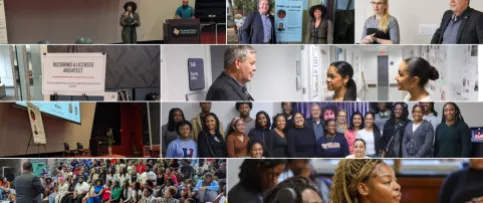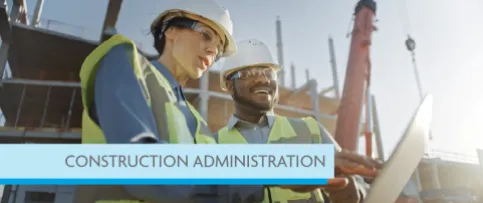In June, New Mexico architect Robert M. Calvani, FAIA, NCARB, was installed as NCARB’s FY21 president. Over the next year, he will lead a focused effort to explore issues related to regulating incidental architecture practice, architects’ responsible charge when signing and sealing documents, and ethics in the profession. We caught up with President Calvani to discuss his start in the profession, the importance of mentoring the next generation of architects, and NCARB’s evolution over the years.
What do you love about architecture?
Architecture impacts the environment, and it impacts people. People who walk into a space and feel good about it, they may not know that that's why they feel good, but I think architects do that for the community and for the environment. People who walk into a space can sense that something is different.
The thing about architecture is that each project is different. If you're doing an animal clinic, you learn what people who run animal clinics do. If you're doing an attorney's office, you learn what attorneys do. You really have to learn what the client needs and what the client wants to make them successful in their business. Everybody—every client—has a problem. Architects help solve those problems.
Early in your career, you started investigating new technologies in the profession. Can you tell us about that?
When I was in college, I really got involved in computers and how computers could draw. We were one of the first colleges to really work on having these machines draw. I really got involved with it. We were using punch cards, and Fortran as the language. When my partner and I started our own firm around 1980, a salesman from Hewlett Packard came along and had a machine that could draw. It was the first AutoCAD. It was about $100,000 and we went to Los Angeles and looked at it, because we were really excited about that technology. The technology at the time was really not user-friendly. We didn’t end up keeping the machine because it was so hard to use, but it was impressive.
Why did you decide to get licensed?
Having a license enables you to have your own firm. When I was working toward completing my experience and examination requirements, everybody got licensed. That was what you needed to do. I always wanted to have my own firm, so that I could make my own way. Having your own firm lets you do what you want to do. It lets you pick the clients that you want to pick and the work you want to do, and it opens up a lot of doors for you.
Tell us about your firm and your work in Albuquerque.
At my firm here in Albuquerque, we have a diverse team of about 18 people, and we do a variety of projects—everything from housing and justice facilities to education and clinics. We're like many architecture firms throughout the nation: we do a little bit of everything. We do work all over the state of New Mexico, and you can see how the state has a lot of variation in architecture style. New Mexico is really made up of different cultures—there's Spanish, Mexican, Native American, and Northern European. The cultures meld, and every community has a different architecture style that makes working fun.
Why is mentoring the next generation important to you?
Young people bring a new kind of knowledge and skills to the firm that older practitioners don't have. It seems like every year, if we hire someone from the university, they bring something else that's different than the year before. Mentoring younger people is something that every architect has an obligation to do. And it's a two-way street: they mentor to me, as well.
Having the right mentor is important in architecture, and I certainly had that. I had the privilege of working with several exceptional mentors during my early career, and I think that's what any architect needs to find. That’s the advice I would give to emerging professionals right now: search around for the right mentor. Find that right supervisor who will teach you everything that you need to know.
One of your goals as president is to raise awareness about the role of architects and NCARB. Why is that important to you?
The work we do at NCARB to regulate the profession and protect the health, safety, and welfare of the public is important. Whether we’re talking about our examination, the experience program, or our efforts to help accredit architecture programs, it's all valuable, and a lot of people don’t see that. I want to reach out to the profession of architecture, and tell them a little more about what NCARB does and how to get involved—the work that our volunteers do is important, and I’d like to help spread the word.
Architects are invaluable to the built environment, and what we do with the built environment is so important that we have to be regulated, and we have to be regulated by architects.
What else do you want to focus on, as president?
During my year as president, I want to focus on what the practitioner does in everyday practice. I've created a couple of volunteer task forces, including one on responsible charge and one on incidental practice.
Architects, as professionals, think we know what responsible charge is. But I question that, and whether there are some architects who seal drawings without true responsible charge. And incidental practice is a problem faced by all licensing boards, but also all practitioners: where's the limit between work done by architects, engineers, landscape architects, and interior designers? We’re also going to focus on the value of licensure and the NCARB Certificate.
What would you say to someone who's thinking about volunteering for the first time?
When I joined the New Mexico Board, I found that the work we were doing to regulate the profession was extremely important. From there, I volunteered to be on a committee. All of the sudden, I was helping write items for the Architect Registration Examination® (ARE®). I wrote questions about toilets and foot candles and elevators and escalators, and I really enjoyed it.
If you're asked to be on a board, or if you're asked to be on an NCARB committee, you should do it. The work that we did on committees is so valuable to the profession and the public.
If you could change one thing about architecture regulation, what would it be, and why?
One of the things I think we need to look at is the path to licensure. Maintaining the rigor of the licensure process is important; however, the path to licensure is nearly 13 years. That may keep us from getting the best and brightest people into our profession. I’d like to look at shortening that time by understanding how our different programs work together, how they don't work together, and where we can make adjustments.


